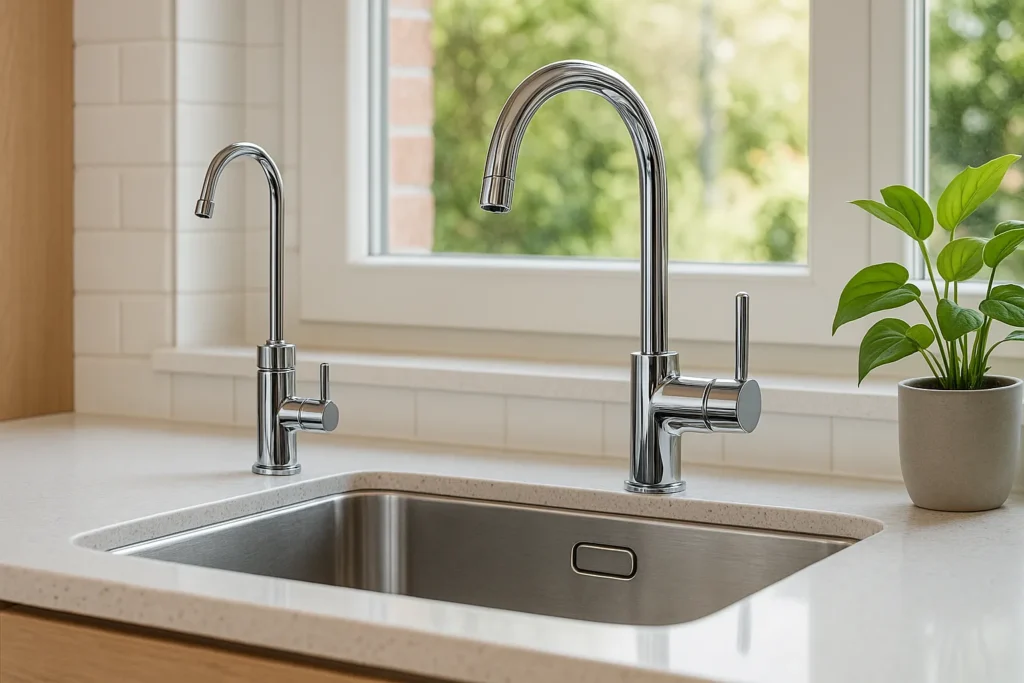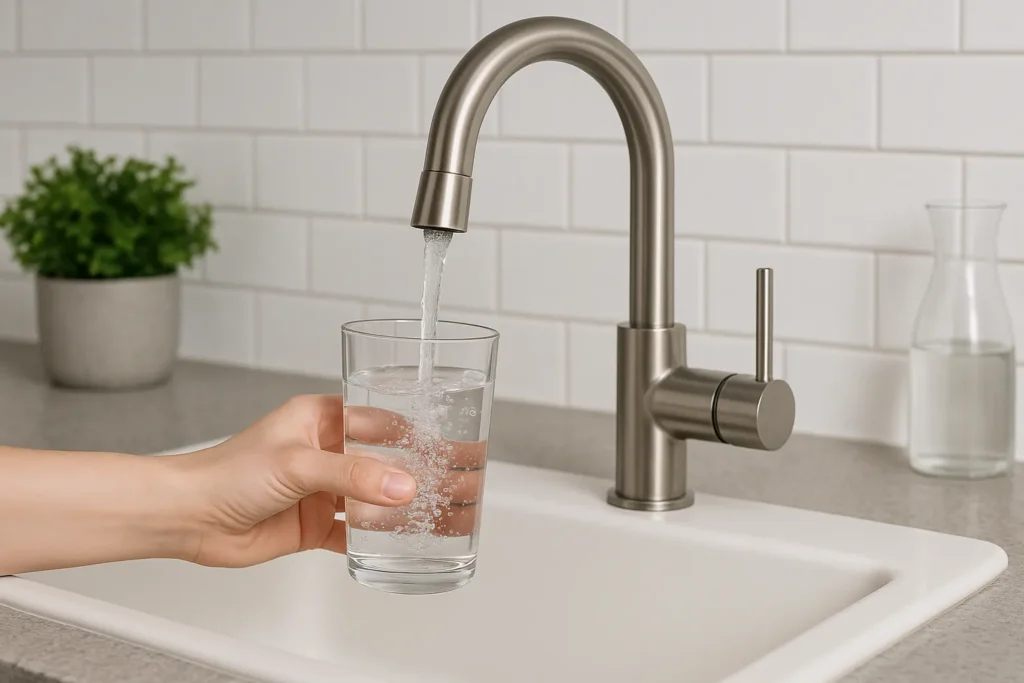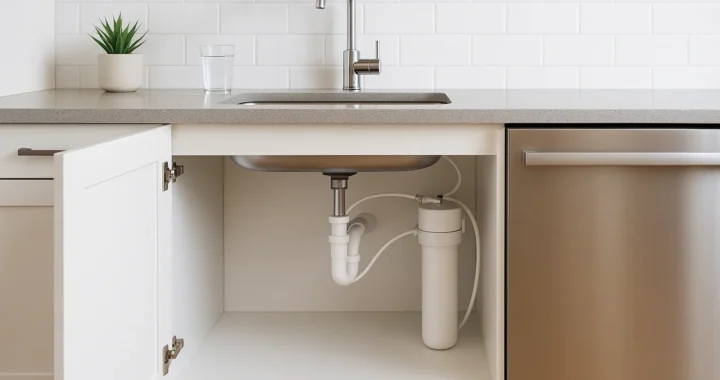Have you ever filled a glass from the tap and hesitated before taking a sip? That chlorine smell or odd aftertaste can make anyone question their water quality and home water safety.
You don’t need to panic because we’ve got you. More like under-sink water filters have got you. Under-sink filtration is a practical way to improve what flows from your taps.
In this guide, we’ll walk you through:
- What’s in Brisbane tap water
- How sink water filtration systems remove contaminants
- Picking the right filter
- Benefits you’ll notice daily
Setting up to drink cleaner water at home is easier than most people expect, and the difference in taste and safety is immediate.
Keep reading to learn everything you need to know about improving your tap water quality.
What’s Really Flowing Through Your Tap?
Your tap water travels a long way before it reaches your glass. Treatment plants work hard to clean the water supply and meet safety standards across Australia. Here’s the thing, though: “safe” doesn’t always mean it tastes great.
Common Contaminants in Treated Water
We all know that chlorine is the main additive used to kill bacteria during the treatment process. It does a great job killing harmful bacteria. But let’s be honest, most people can’t stand the taste or smell. That sharp odour you catch when you turn on the tap? Yep, that’s chlorine.
Alongside that, sediment and rust also find their way into your water. For instance, if you live in older neighbourhoods, those aging pipes shed tiny particles as they break down. Try to recall if you have ever noticed cloudy water or a metallic taste.
Unfortunately, even after passing through treatment plants, some pollutants and trace contaminants stick around. Though the filtration systems at these facilities catch most of the bad stuff, not everything makes it out.
Why Water Quality Varies Across Brisbane
The truth is that where you live affects what comes out of your tap. From our reports, we see that homes in established suburbs usually have older infrastructure, so you’ll find more sediment and rust.
Summer months don’t help either. Sadly, heat makes the chlorine smell stronger, and you’ll taste it more in your drinking water.
Now that you know what’s in your water, let’s look at how you can filter it out.
Under-Sink Filters: How They Work

We have explained what truly runs down your tap. Let’s talk about the solution: under-sink filters. You might wonder how a small filter can tackle all those contaminants.
It’s because these water filters sit beneath your sink and connect directly to your cold water line. So, every time you turn on the tap, the water passes through multiple filter stages before reaching your glass. Basically, each stage targets different types of contaminants and works together to clean what comes through.
Most sink water filter systems use activated carbon to remove chlorine (you must have heard of this technique in your school days in science class). This process improves the taste and smell right away.
Some purification systems add extra layers to catch sediment, bacteria, and other pollutants. Think of it like a security checkpoint for your water. Each filter layer stops specific unwanted particles from getting through.
What you get is cleaner, healthier water straight from your tap. No more lugging heavy bottles from the store, and no more questioning what you’re drinking.
Of course, not every filter suits every home. Here’s how to pick yours.
Choosing Your Ideal Sink Water Filter

Not all water filters deal with the same problems. Some focus on taste, while others remove a broader range of contaminants. That’s why picking the right one depends on your specific needs.
Focus on these factors when shopping around:
- Water concerns: Simple carbon filters handle chlorine taste and odour well. If you have older plumbing, look for ‘multi-stage sink water filters’. These systems catch sediment and rust particles that basic models miss.
- Installation setup: ‘Stand-alone faucets’ give you a separate tap just for filtered water. Then there are mixer taps that let you switch between filtered and regular water using your existing faucet, so your counter stays clean.
- Budget reality: Under-sink systems in Australia usually range from $250 for entry-level models to over $1,000 for advanced purification systems. You’ll also need to replace cartridge filters regularly. From our experience, most systems need new cartridges every 6 to 12 months, which adds to your budget.
- Maintenance needs: Some filters require a plumber to install and service them. Others are simple enough to handle yourself. It’s best that you check how often you need to swap cartridges before you buy to avoid surprise costs later.
Now you are about to install your filter. Come and explore with us what changes you can expect.
The Real Benefits You’ll Notice Daily

The difference in your water starts showing up fast. You’ll quickly notice improvements in taste, smell, and how you feel about drinking tap water at home.
Let’s look at what you can expect after installation:
Taste and Smell Improvements
The chlorine taste will disappear almost instantly. Just imagine that sharp chemical smell you used to catch when filling a glass, suddenly gone. Oh, and the best part is that your morning coffee and tea taste better, too.
You are going to love how the water filters remove the chlorine and odour that interfere with flavour.
Peace of Mind for Your Family
Water filters catch contaminants that slip through treatment plants. The truth is, families with young children benefit even more from this protection. After all, kids drink more water compared to their body size, so removing chlorine and bacteria helps their developing bodies stay healthier.
Plus, cleaner drinking water at home gives you confidence about what your family consumes every day.
Environmental and Financial Wins
Bottled water becomes unnecessary once you install a filter. For example, families who regularly buy bottled water can save hundreds of dollars annually by switching to filtered tap water. But the benefits don’t stop there.
Every filtered glass means one less plastic container heading to a landfill. In fact, households that switch to filters reduce their plastic waste significantly, which in turn helps the environment one glass at a time.
These small changes add up to a healthier home and a cleaner planet.
Your Next Step Toward Better Water Quality
Home water safety doesn’t have to be complicated. A simple under-sink filter improves your tap water quality and gives your family cleaner drinking water every day.
You’ve learned what’s in Brisbane tap water, how sink water filtration systems remove contaminants, and what to look for in filters. The health benefits are real, and the savings add up over time.
Clean water starts at home, but Easy510‘s mission reaches much further. We work to bring water awareness to communities worldwide. After all, everyone deserves access to safe, clean water.
Visit our blog to learn more about water quality and support global water initiatives. Small actions create big changes.

